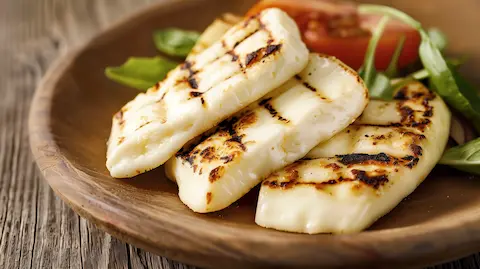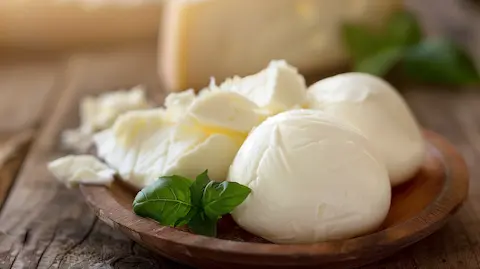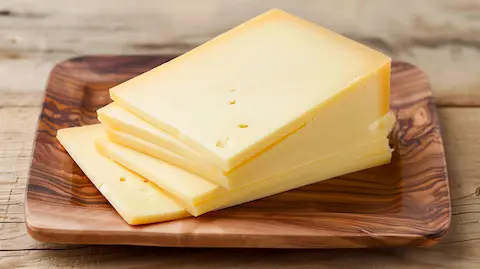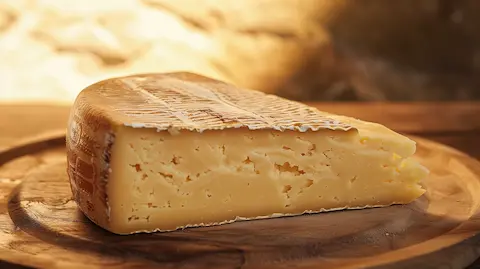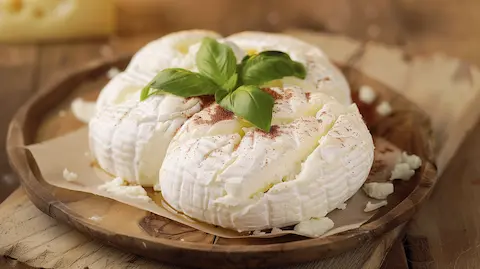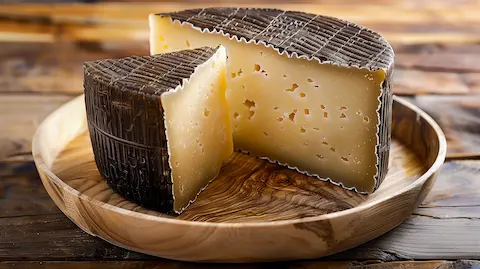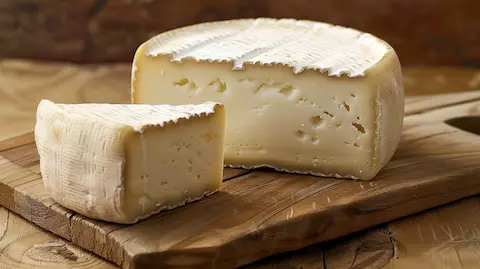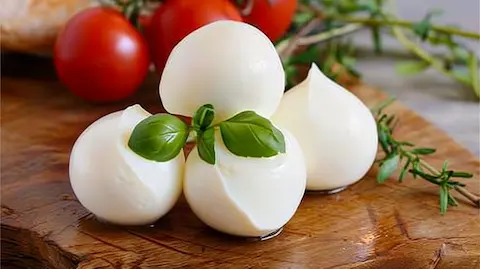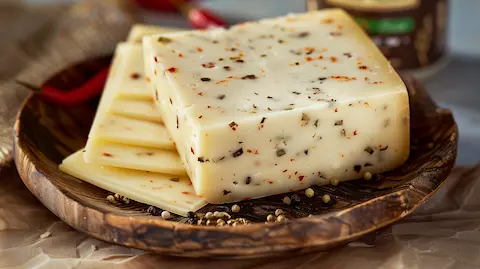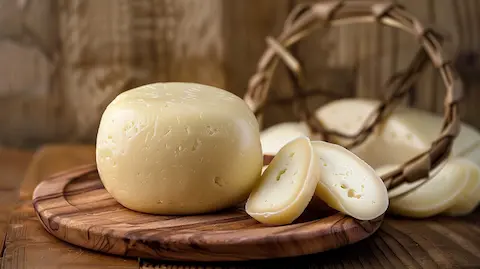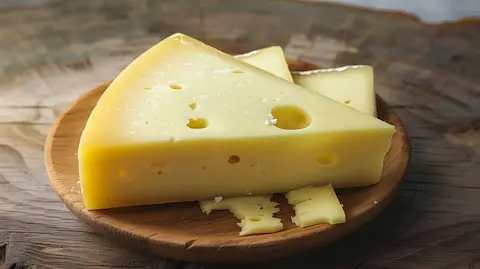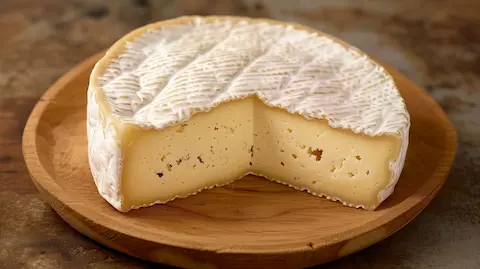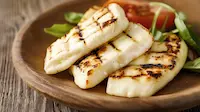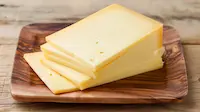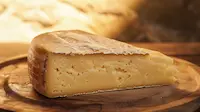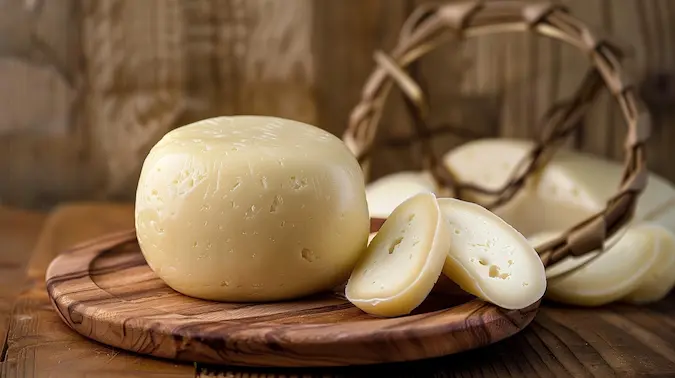Scamorza Cheese
Scamorza, a southern Italian specialty, is a pasta filata cheese akin to mozzarella, known for its pear-like shape and delightful elasticity. Crafted from cow's milk, this cheese undergoes a unique stretching and molding process that imparts a firm, springy texture when fresh and a softer, more yielding quality as it matures. Scamorza comes in two main varieties: a pristine white version and its smoked counterpart, Scamorza Affumicata, which boasts a distinctive brownish hue and a rich, savory flavor profile.
Discover the intricate process behind the creation of Scamorza, from milk to market.
How is Scamorza Made?
Scamorza cheese is made through a meticulous process that begins with the pasteurization of cow's milk. The milk is then inoculated with specific cultures and allowed to ferment slightly before rennet is added to coagulate the milk into curds. These curds are then heated and stretched in hot water, giving Scamorza its characteristic texture. The cheese is molded into its traditional pear shape, salted, and left to dry. For Scamorza Affumicata, the cheese is additionally smoked over wooden chips to achieve its unique flavor.
Here is a detailed table outlining the production process of Scamorza cheese:
Scamorza Cheese Production Process
| Step | Ingredient(s) | Method | Temperature | Duration |
|---|---|---|---|---|
| Pasteurization | Cow's milk | Heat treatment | 72°C (161°F) | 15 seconds |
| Inoculation | Cultures | Addition and fermentation | 37°C (98.6°F) | 1 hour |
| Coagulation | Rennet | Enzymatic reaction | 30 minutes | |
| Stretching | Curd | Heating and stretching in hot water | 80°C (176°F) | Variable |
| Molding | Stretched curd | Shaping into pear form | Variable | |
| Salting | Shaped cheese | Brine bath or dry salting | Variable | |
| Drying | Salted cheese | Air drying | Room temperature | 24 hours |
| Smoking (optional) | Shaped cheese | Exposure to wooden chip smoke | 2-4 hours |
Scamorza Cheese Profile
Scamorza cheese boasts a rich heritage and a unique set of characteristics that distinguish it from other cheeses. Below is a profile that encapsulates the defining aspects of scamorza.
- Made from: Cow's milk
- Country of origin: Italy
- Region: Apulia, Calabria, Campania
- Family: Pasta filata
- Type: Semi-soft (fresh), Soft (aged)
- Texture: Firm and springy when fresh; softer and more elastic with age
- Rind: Natural
- Colour: White, or brownish tint for the smoked variety
- Flavour: Mild and slightly sweet; smoky and savory for Scamorza Affumicata
- Aroma: Milky with a smoky note for Scamorza Affumicata
- Vegetarian: No, due to the use of rennet
- Producers: Various cheesemakers in the specified Italian regions
- Safe for dogs: Not recommended due to lactose content and potential additives
- PDO status: Not a Protected Designation of Origin cheese
How to Store Scamorza?
Proper storage of Scamorza is vital for maintaining its quality and extending its shelf life. Scamorza should be kept in a cool, humid environment, ideally in the lower part of the refrigerator where the temperature is consistent. To prevent the cheese from drying out, wrap Scamorza in cling film or wax paper, then place it in an airtight container or a resealable plastic bag. This method helps to retain moisture and protect the cheese from absorbing other flavors in the fridge.
- Refrigeration: Store in the lower section of the refrigerator.
- Wrapping: Wrap tightly in cling film or wax paper.
- Container: Place in an airtight container or a resealable plastic bag.
- Humidity: Maintain a humid environment within the container if possible.
- Check Regularly: Inspect the cheese periodically for any signs of spoilage.
How long does Scamorza cheese last?
Scamorza cheese has a variable shelf life depending on how it is stored. When kept in the refrigerator, fresh Scamorza typically lasts for up to two weeks, while the smoked variety can last a bit longer due to its smoking process, which imparts some preservative effects. Freezing Scamorza is possible, although it may alter the texture and taste upon thawing, making it more suitable for cooked dishes rather than fresh consumption.
| Storage Location | Fresh Scamorza | Smoked Scamorza | Notes |
|---|---|---|---|
| Outside | 4-6 hours | 4-6 hours | Consume quickly, especially in warm climates. |
| Fridge | Up to 2 weeks | 2-3 weeks | Keep wrapped and in an airtight container. |
| Freezer | Up to 2 months | Up to 2 months | Texture and taste may change when thawed. |
Can You Freeze Scamorza?
Yes, you can freeze Scamorza. Freezing this cheese may change its texture and flavor, making it more suitable for cooked dishes. When freezing, cut Scamorza into small portions, wrap each tightly in plastic wrap, and place them in a freezer bag. Label with the date to track how long it has been stored. Thaw in the refrigerator before use to minimize texture changes.
Alternatives to Scamorza Cheese
While Scamorza has its unique charm, there are several cheeses that can serve as substitutes in recipes or for those seeking a similar taste experience. The following table presents a selection of cheeses that can be used as alternatives to Scamorza, along with specific data to understand why they make good substitutes.
Scamorza Cheese Substitutes
| Cheese | Origin | Milk Source | Texture | Flavor | Best Used In |
|---|---|---|---|---|---|
| Mozzarella | Italy | Cow or Buffalo | Semi-soft, moist | Mild, slightly tangy | Pizzas, salads, sandwiches |
| Provolone | Italy | Cow | Semi-hard | Mild to sharp, depending on aging | Sandwiches, grating, baking |
| Caciocavallo | Italy | Cow | Semi-hard | Tangy, nutty | Grilling, grating, appetizers |
| Gouda | Netherlands | Cow | Semi-soft to hard | Sweet, buttery, mild | Sandwiches, snacks, melting |
| Monterey Jack | United States | Cow | Semi-soft | Mild, creamy | Melting, quesadillas, burgers |
How to Use Scamorza
Scamorza is versatile in the kitchen, easily incorporated into various dishes. When slicing Scamorza for use, a sharp knife is recommended to maintain its shape, especially for the firmer fresh variety. Cut into thin slices for sandwiches or thicker chunks for grilling.
- Grill slices to top burgers or vegetables.
- Melt into risottos or pasta dishes for a creamy texture.
- Shred over pizzas for a gooey topping.
- Cube for antipasto platters or salads.
- Pair with fruit and nuts for a balanced cheese board.
How to Serve Scamorza Cheese
Scamorza, particularly when smoked, adds depth to cheese platters and is excellent when served with crusty bread, olives, and cured meats. For a warm dish, try baking or grilling the cheese until it becomes golden and bubbly.
Recipes Using Scamorza
Scamorza's melting qualities and distinct flavor make it an excellent choice for a variety of recipes. Here are popular dishes where Scamorza shines:
- Scamorza Pizza: Its melting properties create a gooey and stretchy topping, similar to mozzarella but with a unique twist.
- Stuffed Chicken Breast: The cheese's ability to hold its shape when melted makes it ideal for stuffing meats.
- Vegetarian Lasagna: Scamorza adds a smoky depth when used in layers, enhancing the overall flavor profile.
- Grilled Cheese Sandwich: Offers a delightful texture and a smoky kick if using the affumicata variety.
- Baked Scamorza: When baked, it becomes irresistibly creamy, perfect for a decadent appetizer.
Scamorza Nutrition Data
Nutritionally, Scamorza cheese is similar to other semi-soft cheeses, offering a balance of protein and fat. There are 292 calories in Scamorza cheese per 100g. The table below provides a concise view of its nutritional composition, aiding in dietary planning and management.
| Nutrient | Amount per 100g | Unit |
|---|---|---|
| Calories | 292 | kcal |
| Total Fat | 21.5g | g |
| Saturated Fat | 13.9g | g |
| Cholesterol | 79mg | mg |
| Sodium | 619mg | mg |
| Total Carbohydrate | 1.5g | g |
| Dietary Fiber | 0g | g |
| Sugars | 1.5g | g |
| Protein | 22.6g | g |
| Calcium | 700mg | mg |
What's Next? WhatCheese Insights
As the founder of WhatCheese, my passion for cheese is matched only by my dedication to sharing the finest cheese experiences with you. For those seeking to purchase Scamorza, I recommend visiting specialty cheese shops or Italian delis that prioritize quality and authenticity. These establishments often provide the freshest options and knowledgeable cheesemongers who can offer valuable insights into the cheese's origin and best uses.
For an immersive experience, renowned vineyards that offer cheese tastings alongside their wines are a must-visit. These tastings typically feature a curated selection of cheeses, including Scamorza, paired with wines that complement their flavors. The best time to visit is during the harvest season, when the vineyards are abuzz with activity and the cheese is at its peak.
Additionally, cheese festivals and events are fantastic opportunities to explore Scamorza and other artisanal cheeses. These events often feature cheese-making demonstrations, tastings, and the chance to meet the producers. Keep an eye out for annual events such as the Cheese Festival in Bra, Italy, which celebrates cheese culture and provides a platform for cheesemakers to showcase their craft.
If you appreciate the semi-soft texture of Scamorza, I also recommend exploring similar cheeses such as fontina, taleggio, and Havarti. Each of these cheeses offers a unique flavor profile that can enrich your culinary adventures.

